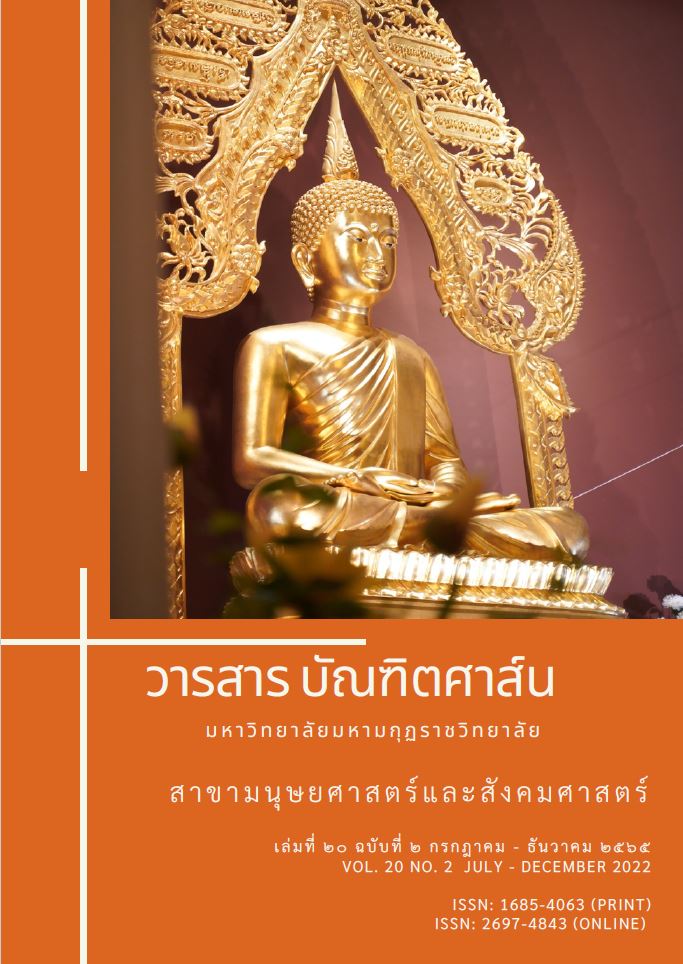ตัวบ่งชี้ภาวะผู้นำการเปลี่ยนแปลงเชิงพรหมวิหารของผู้บริหารสถานศึกษา สังกัดกรุงเทพมหานคร
คำสำคัญ:
ตัวบ่งชี้, ภาวะผู้นำการเปลี่ยนแปลงเชิงพรหมวิหาร, สถานศึกษาสังกัดกรุงเทพมหานคร, พรหมวิหารบทคัดย่อ
การวิจัยนี้มีวัตถุประสงค์เพื่อ 1) พัฒนาตัวบ่งชี้และกำหนดโมเดลความสัมพันธ์เชิงโครงสร้างของตัวบ่งชี้ ภาวะผู้นำการเปลี่ยนแปลงเชิงพรหมวิหาร ของผู้บริหารสถานศึกษา สังกัดกรุงเทพมหานคร 2) ทดสอบความสอดคล้องกลมกลืนของโมเดลความสัมพันธ์เชิงโครงสร้างตัวบ่งชี้ภาวะผู้นำการเปลี่ยนแปลงเชิงพรหมวิหาร ของผู้บริหารสถานศึกษา สังกัดกรุงเทพมหานคร ที่พัฒนาขึ้นกับข้อมูลเชิงประจักษ์ 3) ระบุองค์ประกอบตัวบ่งชี้ และพฤติกรรมบ่งชี้ที่มีค่าความเที่ยงตรงเชิงโครงสร้าง หรือค่าน้ำหนักองค์ประกอบตามเกณฑ์ที่กำหนด 4) ศึกษาแนวทางการพัฒนาภาวะผู้นำการเปลี่ยนแปลงเชิงพรหมวิหาร ของผู้บริหารสถานศึกษา สังกัดกรุงเทพมหานคร โดยแบบการวิจัยแบบผสมผสาน (Mixed methods Research) คือผสมผสานวิธีวิจัยเชิงคุณภาพ (Qualitative Research) และวิจัยเชิงปริมาณ (Quantitative Research) กลุ่มตัวอย่างที่ใช้ในการวิจัย คือ สถานศึกษา สังกัดกรุงเทพมหานคร จำนวนทั้งหมด 205 โรงเรียน ผู้ให้ข้อมูล คือ ผู้บริหารสถานศึกษา หัวหน้างานวิชาการ และครูผู้สอน รวมผู้ให้ข้อมูลทั้งสิ้น 615 คน เครื่องมือที่ใช้เก็บรวบรวมข้อมูล จำนวน 2 ชุด ได้แก่ 1) แบบสอบถามเกี่ยวกับภาวะผู้นำการเปลี่ยนแปลงเชิงพรหมวิหาร ของผู้บริหารสถานศึกษา สังกัดกรุงเทพมหานคร 2) แบบสัมภาษณ์ชนิดมีโครงสร้าง ใช้เก็บรวบรวมข้อมูลในปีพุทธศักราช 2563 สถิติที่ใช้ในการวิเคราะห์ข้อมูลได้แก่ การคำนวณหาค่าเฉลี่ย (Mean) การคำนวณหาส่วนเบี่ยงเบนมาตรฐาน (Standard deviation) การคำนวณค่าสัมประสิทธิ์การกระจาย (coefficient of variation) การวิเคราะห์องค์ประกอบเชิงยืนยัน (Confirmatory factor analysis) โดยใช้โปรแกรมสำเร็จรูปทางสถิติ
ผลการวิจัยพบว่า
1) พัฒนาตัวบ่งชี้และกำหนดโมเดลความสัมพันธ์เชิงโครงสร้างของตัวบ่งชี้ภาวะผู้นำการเปลี่ยนแปลงเชิงพรหมวิหาร ของผู้บริหารสถานศึกษา สังกัดกรุงเทพมหานคร เพื่อคัดสรรกำหนดไว้ในโมเดลความสัมพันธ์โครงสร้างโดยใช้เกณฑ์ค่าเฉลี่ยเท่ากับหรือมากกว่า 3.00 และค่าสัมประสิทธิ์การกระจายเท่ากับหรือต่ำกว่า 20% ผลการวิเคราะห์แยกออกเป็นแต่ละองค์ประกอบ คือ 1) การมีอิทธิพลอย่างมีอุดมการณ์อันประกอบด้วยพรหมวิหาร ประกอบด้วย ตัวบ่งชี้ 4 ตัว การมีอิทธิพลอย่างมีอุดมการณ์อันประกอบด้วยเมตตา การมีอิทธิพลอย่างมีอุดมการณ์อันประกอบด้วยกรุณา การมีอิทธิพลอย่างมีอุดมการณ์อันประกอบด้วยมุทิตา และการมีอิทธิพลอย่างมีอุดมการณ์อันประกอบด้วยอุเบกขา 2) องค์ประกอบการสร้างแรงบันดาลใจอันประกอบด้วยพรหมวิหาร ประกอบด้วยตัวบ่งชี้ 4 ตัว คือ การสร้างแรงบันดาลใจอันประกอบด้วยเมตตา การสร้างแรงบันดาลใจอันประกอบด้วยกรุณา การสร้างแรงบันดาลใจอันประกอบด้วยมุทิตา และการสร้างแรงบันดาลใจอันประกอบด้วยอุเบกขา 3) องค์ประกอบการกระตุ้นทางปัญญา อันประกอบด้วย พรหมวิหาร ประกอบด้วยตัวบ่งชี้ 4 ตัว คือ การกระตุ้นทางปัญญาอันประกอบด้วยเมตตา การกระตุ้นทางปัญญาอันประกอบด้วยกรุณา การกระตุ้นทางปัญญาอันประกอบด้วยมุทิตา และการกระตุ้นทางปัญญา อันประกอบด้วยอุเบกขา 4) องค์ประกอบ การคำนึงถึงความเป็นปัจเจกบุคคลอันประกอบด้วยพรหมวิหาร ประกอบด้วยตัวบ่งชี้ 4 ตัว คือ การคำนึงถึงความเป็นปัจเจกบุคคลอันประกอบด้วยเมตตา การคำนึงถึงความเป็นปัจเจกบุคคล อันประกอบด้วยกรุณา การคำนึงถึงความเป็นปัจเจกบุคคลอันประกอบด้วยมุทิตา และการคำนึงถึงความเป็นปัจเจกบุคคลอันประกอบด้วยอุเบกขา
2) ผลการวิเคราะห์องค์ประกอบเชิงยืนยันของโมเดลทั้ง 4 โมเดล พบว่า ทุกโมเดลตามสมมติฐานการวิจัยสอดคล้องกับข้อมูลเชิงประจักษ์ดีมาก นอกจากนี้ ค่าน้ำหนักองค์ประกอบของตัวบ่งชี้มีนัยสำคัญทางสถิติทุกค่า แสดงว่าตัวบ่งชี้ทั้งหมดนี้เป็นตัวบ่งชี้ที่สำคัญขององค์ประกอบภาวะผู้นำการเปลี่ยนแปลงเชิงพรหมวิหารของผู้บริหารสถานศึกษาสังกัดกรุงเทพมหานคร
3) ผลการวิเคราะห์ค่าสัมประสิทธิ์สหสัมพันธ์แบบเพียร์สันของโมเดล ตัวบ่งชี้ภาวะผู้นำการเปลี่ยนแปลงเชิงพรหมวิหารของผู้บริหารสถานศึกษาสังกัดกรุงเทพมหานคร พบว่า ตัวบ่งชี้ทั้ง 16 ตัว มีความสัมพันธ์กันเชิงบวกอย่างมีนัยสำคัญทางสถิติที่ระดับ .01 (p < .01) โดยตัวบ่งชี้ที่มีความสัมพันธ์สูงที่สุด คือ การมีอิทธิพลอย่างมีอุดมการณ์อันประกอบด้วยกรุณาและการมีอิทธิพลอย่างมีอุดมการณ์อันประกอบด้วยอุเบกขา คือ มีค่าสัมประสิทธิ์สหสัมพันธ์เท่ากับ 0.705 ส่วนตัวบ่งชี้ที่มีความสัมพันธ์กันน้อยที่สุดคือการสร้างแรงบันดาลใจอันประกอบด้วยมุทิตา และการคำนึงถึงความเป็นปัจเจกบุคคลอันประกอบด้วยกรุณาคือ มีค่าสัมประสิทธิ์สหสัมพันธ์เท่ากับ 0.140
4) ผลที่ได้จากการวิเคราะห์ข้อมูลใน 4 องค์ประกอบดังกล่าวข้างต้นผู้เชี่ยวชาญมีความเห็นและมีการปฏิบัติรวมทั้งมีการส่งเสริมสนับสนุนให้บุคลากรนำองค์ประกอบและตัวบ่งชี้ทุกตัวไปปฏิบัติในการดำเนินงานจริง ซึ่งสอดคล้องหรือเป็นไปในทิศทางเดียวกันกับผลการวิจัย ที่ผู้วิจัยได้พัฒนาขึ้น
เอกสารอ้างอิง
กระทรวงศึกษาธิการ. (2548). การพัฒนาคุณภาพการบริหารการศึกษาตามระบบคุณธรรม. กรุงเทพมหานคร : โรงพิมพ์คุรุสภาลาดพร้าว.
จุฬาลงกรณ์มหาวิทยาลัย. คณะครุศาสตร์. (2552). รายงานการพัฒนาตัวบ่งชี้และเครื่องมือวัดตัวบ่งชี้
ตามมาตรฐานการศึกษาของชาติ มาตรฐานที่ 2 แนวทางการจัดการศึกษา มาตรฐานที่ 3
แนวทางการสร้างสังคมแห่งการเรียนรู้ กรุงเทพฯ: คณะครุศาสตร์ จุฬาลงกรณ์มหาวิทยาลัย.
ธีระ รุญเจริญ. (2553). ความเป็นมืออาชีพในการจัดและบริหารการศึกษายุคปฏิรูปการศึกษา.
พิมพ์ครั้งที่ 5 กรุงเทพฯ: ข้าวฟ่าง.
กรุงเทพฯ : สำนักงานคณะกรรมการพัฒนาระบบราชการ.
สำนักงานรับรองมาตรฐานและประเมินคุณภาพการศึกษา (องค์การมหาชน). (2555). คู่มือการ
ประเมินคุณภาพภายนอกรอบสาม (2554-2558):ฉบับสถานศึกษา (แก้ไขเพิ่มเติม
พฤศจิกายน พ.ศ.2554). (พิมพ์ครั้งที่ 2). กรุงเทพฯ : ออฟเซ็ท พลัส.
พระราชบัญญัติการศึกษาแห่งชาติ. (2556). พระราชบัญญัติการศึกษาแห่งชาติ พุทธศักราช 2542
แก้ไข เพิ่มเติม (ฉบับที่ 2) พุทธศักราช 2545 และ (ฉบับที่ 3) พุทธศักราช 2553
ฉบับราชกิจจานุเบกษา. สืบค้นเมื่อ 10 มกราคม 2562 (ออนไลน์) เข้าถึงได้จาก http://www. ratchakitcha.soc.go.th/ DATA/PDF/2553/a/045/1.PDF
ดาวน์โหลด
เผยแพร่แล้ว
รูปแบบการอ้างอิง
ฉบับ
ประเภทบทความ
สัญญาอนุญาต
ลิขสิทธิ์ (c) 2022 มหาวิทยาลัยมหามกุฏราชวิทยาลัย

อนุญาตภายใต้เงื่อนไข Creative Commons Attribution-NonCommercial-NoDerivatives 4.0 International License.
บทความวิชาการและบทความวิจัยในวารสารฉบับนี้ถือเป็นความรับผิดชอบของผู้เขียนเท่านั้น บทความที่ได้รับการตีพิมพ์ในวารสารบัณฑิตศาส์น ถือเป็นลิขสิทธิ์ของมหาวิทยาลัยมหามกุฏราชวิทยาลัย ตามพระราชบัญญัติลิขสิทธิ์



